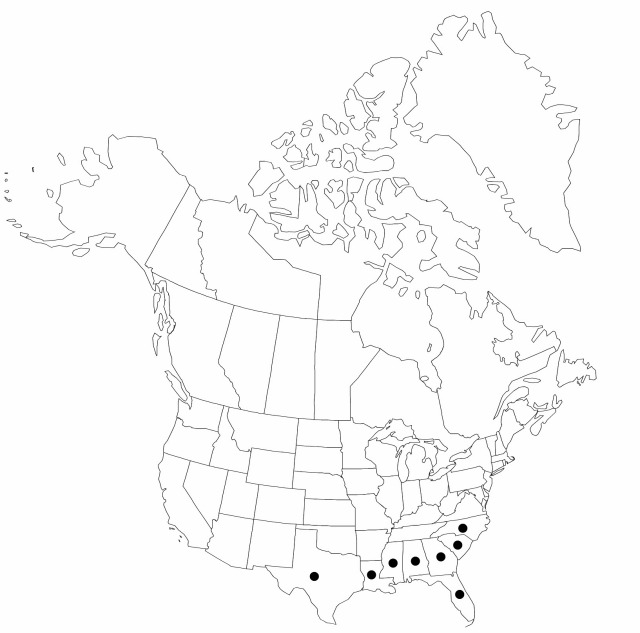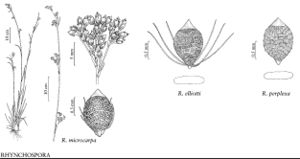Difference between revisions of "Rhynchospora elliottii"
Sp. Pl. 2: 69. 1833.
FNA>Volume Importer |
FNA>Volume Importer |
||
| Line 14: | Line 14: | ||
|name=Phaeocephalum schoenoides | |name=Phaeocephalum schoenoides | ||
|authority=(Alph. Wood) House | |authority=(Alph. Wood) House | ||
| − | }}{{Treatment/ID/Synonym | + | }} {{Treatment/ID/Synonym |
|name=Rhynchospora multiflora | |name=Rhynchospora multiflora | ||
|authority=A. Gray | |authority=A. Gray | ||
| − | }}{{Treatment/ID/Synonym | + | }} {{Treatment/ID/Synonym |
|name=Rhynchospora schoenoides | |name=Rhynchospora schoenoides | ||
|authority=Alph. Wood | |authority=Alph. Wood | ||
| Line 35: | Line 35: | ||
|elevation=0–200 m | |elevation=0–200 m | ||
|distribution=Ala.;Fla.;Ga.;La.;Miss.;N.C.;S.C.;Tex. | |distribution=Ala.;Fla.;Ga.;La.;Miss.;N.C.;S.C.;Tex. | ||
| − | |discussion=<p>Rhynchospora elliottii is most likely to be confused in the field with its frequent associates R. microcarpa and R. perplexa. Most of the time it can be distinguished from both by its taller, coarser, broader-leaved habit and by its distinctly redder spikelets. Inspection of the fruit reveals the spreading character of the perianth bristles, these usually a length level with the tubercle tip or longer and giving the whole structure the appearance of an unengorged tick.</p> | + | |discussion=<p><i>Rhynchospora elliottii</i> is most likely to be confused in the field with its frequent associates <i>R. microcarpa</i> and <i>R. perplexa</i>. Most of the time it can be distinguished from both by its taller, coarser, broader-leaved habit and by its distinctly redder spikelets. Inspection of the fruit reveals the spreading character of the perianth bristles, these usually a length level with the tubercle tip or longer and giving the whole structure the appearance of an unengorged tick.</p> |
|tables= | |tables= | ||
|references= | |references= | ||
| Line 59: | Line 59: | ||
|publication year=1833 | |publication year=1833 | ||
|special status= | |special status= | ||
| − | |source xml=https://jpend@bitbucket.org/aafc-mbb/fna-data-curation.git/src/ | + | |source xml=https://jpend@bitbucket.org/aafc-mbb/fna-data-curation.git/src/8f726806613d60c220dc4493de13607dd3150896/coarse_grained_fna_xml/V23/V23_404.xml |
|genus=Rhynchospora | |genus=Rhynchospora | ||
|species=Rhynchospora elliottii | |species=Rhynchospora elliottii | ||
Revision as of 16:07, 18 September 2019
Plants perennial, cespitose, 80–150 cm; rhizomes absent. Culms erect with arching tops, leafy, obscurely trigonous, slender. Leaves overtopped by inflorescence; blades linear, proximally flat, 3–5 mm wide, apex trigonous, subulate, tapering. Inflorescences: spikelet clusters mostly 4–6, various in shape and crowding, narrowly to broadly turbinate; peduncles erect, branches slender, ascending; leafy bracts exceeding all but most distal clusters. Spikelets redbrown, broadly ellipsoid, (1.5–)2–3(–3.5) mm, apex acute; fertile scales broadly ovate, 2–3 mm, midrib excurrent as apiculus or awn. Flowers: perianth bristles 6, mostly spreading, usually exceeding tubercle, antrorsely barbellate. Fruits 2–3(–4) per spikelet, 1.5(–1.7) mm; body pale brown to brown, strongly flattened, obovoidorbicular, 1–1.2 × 0.8–1.1; surfaces transversely wavyrugose, intervals vertically striate with very narrowly rectangular alveolae; tubercle flat, triangular or concavely triangular, 0.3–0.5(–0.7) mm.
Phenology: Fruiting late spring–fall or all year (south).
Habitat: Sands and peats of bogs, shorelines, interdunal swales, savannas, and pine flatwoods
Elevation: 0–200 m
Distribution

Ala., Fla., Ga., La., Miss., N.C., S.C., Tex.
Discussion
Rhynchospora elliottii is most likely to be confused in the field with its frequent associates R. microcarpa and R. perplexa. Most of the time it can be distinguished from both by its taller, coarser, broader-leaved habit and by its distinctly redder spikelets. Inspection of the fruit reveals the spreading character of the perianth bristles, these usually a length level with the tubercle tip or longer and giving the whole structure the appearance of an unengorged tick.
Selected References
None.
